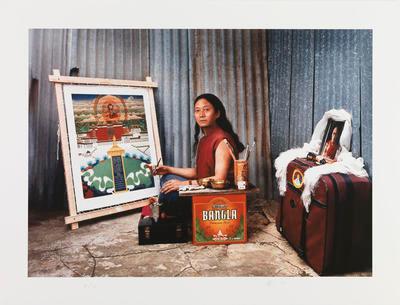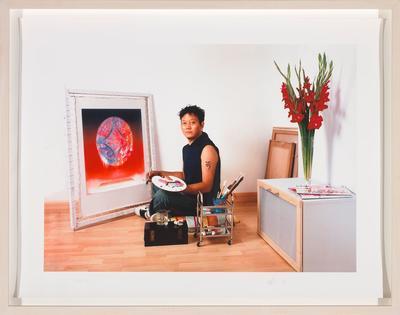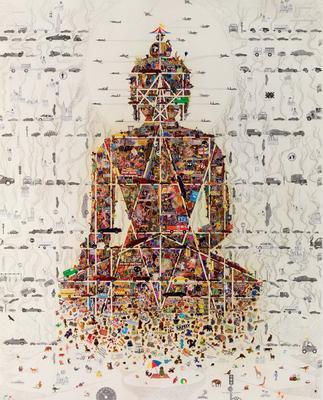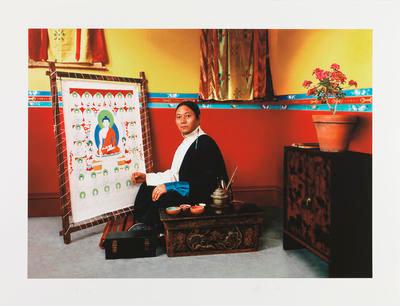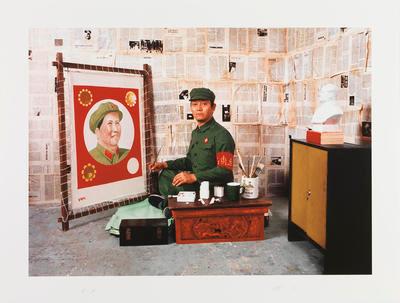Person
Artist
Gonkar Gyatso
贡嘎嘉措
Date of birth
1961
Place Of birth
Lhasa, Tibet, China
Biography
Born in Lhasa, Tibet in 1961. He is trained in traditional Chinese calligraphy and landscape in China, before returning to his homeland to become a leading artist and spokesperson for contemporary artists in Tibet's capital, Lhasa. In 1996 Gyatso moved to London where he lives still in voluntary exile.
He grew up in an environment of Maoist ideology and imagery - his father was a soldier in the People's Liberation Army, and his mother a clerk in a government office. He says: "Everything in our home was Chinese and the entire family adhered to Party guidelines." Gyatso first began to question the Chinese authorities' dominance of Tibet when he visited a rural area on an official mission and was dismayed by the poverty among his fellow Tibetans as a result of government policies that demanded that Tibetan farmers donate their crop yield to the Chinese authorities. Gyatso studied in Beijing and later in Lhasa, and became more aware of the distinctiveness of his own "minority" heritage. In conversations with other art students, Gyatso at first continued to defend Maoism, but gradually came to the realization that many other young Tibetans shared his personal crisis. All suffered from a sense of ‘split personality’ as a result of reaching adulthood in a version of Tibet constructed by China. As a means of reinstating Tibetan identity and rejecting the styles of Chinese masters, Gyatso founded the "Sweet Tea House" school of contemporary artists in Lhasa in the late 1980s. In 1989, shocked by the Chinese government crackdown in Lhasa after pro-independence protests and by the Tiananmen Square massacres in Beijing, Gyatso produced a series of fiery red -seated Buddha images in which the basic colors were stained into cotton cloth and then drenched with further layers of black ink. Gyatso left Tibet for exile in 1992, travelling first to Dharamasala and later to the United Kingdom. Today he has an art gallery in London - the “Sweet Tea House Gallery”, which showcases contemporary Tibetan art.
He grew up in an environment of Maoist ideology and imagery - his father was a soldier in the People's Liberation Army, and his mother a clerk in a government office. He says: "Everything in our home was Chinese and the entire family adhered to Party guidelines." Gyatso first began to question the Chinese authorities' dominance of Tibet when he visited a rural area on an official mission and was dismayed by the poverty among his fellow Tibetans as a result of government policies that demanded that Tibetan farmers donate their crop yield to the Chinese authorities. Gyatso studied in Beijing and later in Lhasa, and became more aware of the distinctiveness of his own "minority" heritage. In conversations with other art students, Gyatso at first continued to defend Maoism, but gradually came to the realization that many other young Tibetans shared his personal crisis. All suffered from a sense of ‘split personality’ as a result of reaching adulthood in a version of Tibet constructed by China. As a means of reinstating Tibetan identity and rejecting the styles of Chinese masters, Gyatso founded the "Sweet Tea House" school of contemporary artists in Lhasa in the late 1980s. In 1989, shocked by the Chinese government crackdown in Lhasa after pro-independence protests and by the Tiananmen Square massacres in Beijing, Gyatso produced a series of fiery red -seated Buddha images in which the basic colors were stained into cotton cloth and then drenched with further layers of black ink. Gyatso left Tibet for exile in 1992, travelling first to Dharamasala and later to the United Kingdom. Today he has an art gallery in London - the “Sweet Tea House Gallery”, which showcases contemporary Tibetan art.

